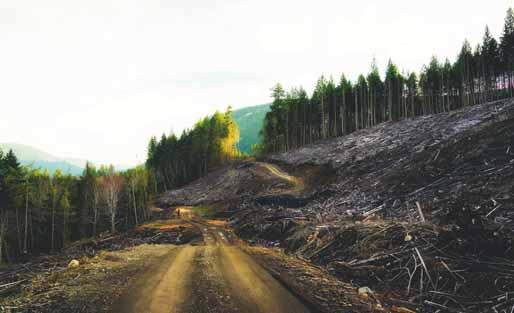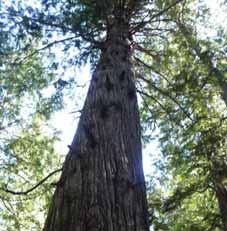
5 minute read
Saying Y.E.S. to Nature
Protecting Communities and Nature with a New Forest Act
BY GUY DAUNCEY
One winter afternoon in 2021, after a big winter storm, Carolyn and I were enjoying some time off at Cowichan Bay. As we strolled down the dock, expecting to see the sea lions, we saw instead something that astonished us. The entire sea had turned brown — murky brown. The sea lions had fled, along with any transient sailors. The fish and ducks had surely fled too. “It happens every year,” we were told.
It wasn’t the Cowichan River that was producing the muddy water. It was the Koksilah River, Xwulqw'selu Sta'lo', that flows across the traditional territories of the Quw’utsun’, Malahat and other First Nations. Clearcut loggers had stripped the mountainsides of their trees, exposing the soil, and the downpour had done the rest, washing the finer topsoil soil off the mountains, into hundreds of logging roads and ditches, into the Koksilah River and into the sea, gone forever. It took twelve thousand years to build that soil.
In summer, the opposite happens. Without the forest to hold the water, the gradual seepage of rain into forest, soil and river has weakened, creating exceptionally low summer flows, which threaten the survival of the salmon and other fish, and the livelihoods of the farmers who depend on the water.
Why do we allow such logging? It creates profits for Mosaic Forest Management, which manages the land for TimberWest and Island Timberlands, but it creates so much harm to nature and local communities.
A similar thing happened in Grand Forks, where Jennifer Houghton was flooded out of her home not once but three times in the four years she lived there. She is really clear that it’s negligent clearcutting that is causing the devastating floods.

After burying themselves in BC’s forestry laws, the members of the Boundary Forest Watershed Stewardship Society have come to a clear conclusion. The laws have to go, to be replaced by a New Forest Act that will ensure that forest management on public land focuses on the interests of communities and nature as well as the owners and licence holders, rather than only the interests of the logging companies and their investors. Under the new proposed legislation, the primary objective of forest management would be to maintain the ecological integrity of forest ecosystems. It’s known to professional foresters as nature-directed stewardship.
To build support, they have created a roadshow titled the Power of Forests, and it’s coming to the Beban Park Social Centre in Nanaimo on Saturday September 14, from noon to 4:30 p.m.
Under the current legislation, tenures held by private corporations are protected. “Professional reliance” is written into policies and regulations, allowing corporations to monitor themselves while making short-term profits their primary objective. There are no negative consequences for companies that degrade the land or eliminate local jobs. This gives the tenure holders no reason to switch to an ecological paradigm. Chipping away at the current legislation one policy at a time would take forever, and meanwhile, the forest destruction would continue.
The proposed New Forest Act would phase out the current forest tenures and “professional reliance.” It would decentralize decision-making to local communities and First Nations through Community Forest Boards. A new ministry, jointly managed by the government and First Nations, would administer the new legislation and policies, and an independent non-partisan Office of the Forester General would report to the legislature and the public on forest management. Local Ranger Stations would be reinstated, ensuring that monitoring and compliance were public functions. Watershed boundaries would become forest management boundaries.
The existing Forest Act would be gradually repealed, along with the Forest and Range Practices Act and the Private Managed Forest Land Act, which governs the Mosaic lands on the east coast of the Island (the old E&N landgrant). The Water Sustainability Act would remain and be fully implemented. All existing licences would be dissolved when their five-year renewal comes up, permitting a gradual transition to the New Forest Act and the new system of community licencing. This would give the forest industry and communities time to adjust.

The Private Managed Forest Lands are our biggest concern locally. They are only five per cent of BC’s forest land base, but their governance is even more ecologically exploitative than it is for public land. There are two proposals to change the way these lands are managed. The first is wording in the New Forest Act that would apply the same nature-directed stewardship principles to the Private Managed Forest Land Act. The second is being developed by Daniel Arbour, regional director for Baynes Sound, Denman and Hornby in the Comox Valley Regional District. He wants the province to devolve powers to the regional districts and First Nations, giving them zoning and regulatory powers to govern how the forest is managed. The ministry has shown no interest in modernizing the Private Managed Forest Land Act to include ecosystem-based management.
If you are free, come join us on September 14. Tickets are free at https:// boundaryforest.org/problem-solution/. That total browning of the sea at Cowichan Bay was an ecological disaster. If we don’t change our forest policies, it will happen again and again and again, until there is no soil left.




